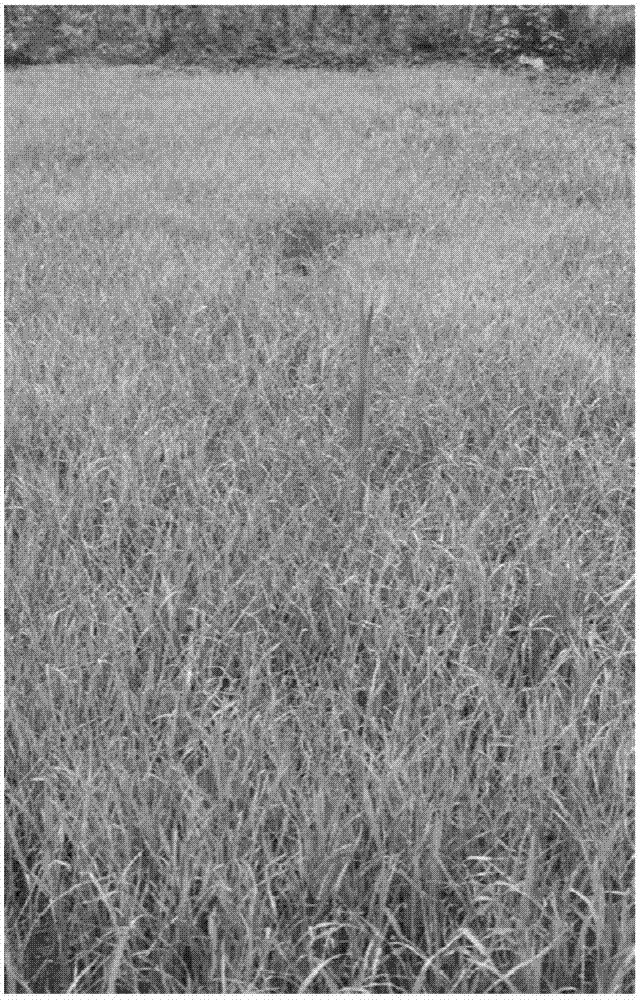ALS (Acetolactate Synthetase) mutant type gene of japonica rice and application of protein of ALS mutant type gene in aspect of herbicide resistance
A mutant and gene technology, applied in the field of plant protein and plant herbicide resistance, can solve the problems of mutation, it is difficult to predict the herbicide resistance of ALS protein in advance, and no one has reported the ALS locus of japonica rice
- Summary
- Abstract
- Description
- Claims
- Application Information
AI Technical Summary
Problems solved by technology
Method used
Image
Examples
Embodiment 1
[0036] Example 1: The process of obtaining the imidazolinone herbicide-resistant mutant of the japonica rice Zhendao 18 (Bailongtong)
[0037]Soak 150kg of japonica rice conventional rice Zhendao 18 (this is M0, soaked in water for 2 hours) 6 times with 0.5-1.0% (w / w) ethyl methanesulfonate (EMS) at room temperature for 6-9 hours During this period, the seeds were shaken every 1 hour; the EMS solution was discarded, and the seeds were stirred and soaked in tap water 5 times for 5 minutes each time, then the seeds were rinsed with tap water overnight, and the field was sown the next day, and routine fertilizer and water management (this is M1) was carried out. After the plants are mature, the seeds are mixed, dried, and stored for the winter. Sow in the field the following year. When the rice (this is M2) seedlings grow to the 3-4 leaf stage, spray 3mL Bailongtong / L water ("Bailongtong" is a water-based imidazolinone herbicide produced by BASF in Germany, it is recommended Th...
Embodiment 2
[0038] Example 2: Analysis of mutation sites of japonica rice mutants resistant to imidazolinone herbicides
[0039] The herbicide-resistant japonica rice mutant plants obtained in the above-mentioned Example 1 were taken to select the leaves of the mutant plants, and the genomic DNA was extracted respectively, and sent to Shanghai Hanyu Biotechnology Co., Ltd. for genome sequencing. Comparing the sequencing results with the reference gene sequence of japonica rice (https: / / www.ncbi.nlm.nih.gov / nuccore / XM_015770973.1), it was found that the above herbicide-resistant japonica rice mutant had one locus in the ALS gene Mutation, wherein the herbicide-resistant mutant plants have a mutation at the 536th base of the ALS gene, changing from C to T, resulting in a change from alanine to valine at the 179th position of the corresponding encoded amino acid sequence, that is The nucleotide sequence of the ALS gene of the herbicide-resistant mutant plant is shown in SEQ ID NO.1, and the ...
Embodiment 3
[0040] Example 3 Cloning of the ALS gene of the japonica rice mutant resistant to imidazolinone herbicides
[0041] The leaves of the above-mentioned herbicide-resistant japonica rice mutant zhen4 were taken, and the genomic DNA of the mutant zhen4 was extracted respectively. According to the chromosomal sequence of the rice japonica wild-type ALS gene (such as Genbank accession number XM_015770973.1), the specific primers for amplifying the ALS gene were designed: forward primer F5'-ATCCGAGCCACACATCGCCTCAC-3', reverse primer R5'-CTCTTTATGGGTCATTCAGGTCAA-3 '.
[0042] Using OneTaq TM Quick 2×Master Mix (purchased from NEB Company, article number: M0483L) amplifies the 5' end sequence and 3' end sequence of the ALS gene, and the reaction system is as follows:
[0043]
[0044] The PCR amplification reaction program adopts a two-step method, annealing and extension are combined together, and 68 degrees are used.
[0045] The program is as follows: pre-denaturation: 98°C...
PUM
 Login to View More
Login to View More Abstract
Description
Claims
Application Information
 Login to View More
Login to View More - R&D
- Intellectual Property
- Life Sciences
- Materials
- Tech Scout
- Unparalleled Data Quality
- Higher Quality Content
- 60% Fewer Hallucinations
Browse by: Latest US Patents, China's latest patents, Technical Efficacy Thesaurus, Application Domain, Technology Topic, Popular Technical Reports.
© 2025 PatSnap. All rights reserved.Legal|Privacy policy|Modern Slavery Act Transparency Statement|Sitemap|About US| Contact US: help@patsnap.com



